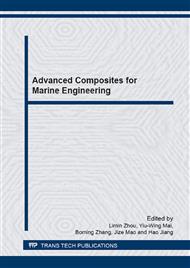[1]
M.A. Meyers, P.Y. Chen, A. Lin, Y. Seki, Biological materials: Structure and mechanical properties, Progress in Materials Science 53(2008), 1-206.
DOI: 10.1016/j.pmatsci.2007.05.002
Google Scholar
[2]
A.P. Jackson, J.F.V. Vincent, R.M. Turner, The Mechanical Design of Nacre, Proceedings of the Royal Society of London Series B-Biological Sciences 234(1988), 415-440.
Google Scholar
[3]
H. Gao, B. Ji, I.L. Jager, E. Arzt, P. Fratzl, Materials become insensitive to flaws at nanoscale: Lessons from nature, Proc. Natl. Acad. Sci. USA 100(2003), 5597-5600.
DOI: 10.1073/pnas.0631609100
Google Scholar
[4]
B. Ji, H. Gao, Mechanical properties of nanostructure of biological materials, J. Mech. Phys. Solids 52(2004), 1963-(1990).
Google Scholar
[5]
H. Gao, B. Ji, M.J. Buehler, H. Yao, Flaw tolerant nanostructures of biological materials, In: W. Gutkowski, T.A. Kowalewski(Eds. ), Mechanics of the 21st Century, Springer, Dordrecht, Netherlands, 2005, pp.131-138.
DOI: 10.1007/1-4020-3559-4_7
Google Scholar
[6]
H. Gao, S. Chen, Flaw tolerance in a thin strip under tension, Journal of Applied Mechanics, 72(2005), 732-737.
DOI: 10.1115/1.1988348
Google Scholar
[7]
H. Gao, H. Yao, Shape insentitive optimal adhesion of nanoscale fibrillar structures, Proc. Natl. Acad. Sci. USA. 101(2004), 7851-7856.
DOI: 10.1073/pnas.0400757101
Google Scholar
[8]
H. Yao, H. Gao, Mechanics of robust and releasable adhesion in biology: bottom-up designed hierarchical structures of gecko, J. Mech. Phys. Solids 54(2006), 1120-1146.
DOI: 10.1016/j.jmps.2006.01.002
Google Scholar
[9]
T. Zhang, X. Li, S. Kadkhodaei, H. Gao, Flaw insensitive fracture in nanocrystalline graphene, Nano Letter. 12(2012), 4605-4610.
DOI: 10.1021/nl301908b
Google Scholar
[10]
H. Gao, Application of fracture mechanics concepts to hierarchical biomechanics of bone and bone-like materials, International Journal of Fracture 138(2006), 101-137.
DOI: 10.1007/s10704-006-7156-4
Google Scholar
[11]
Z. Zhang, Y.W. Zhang, H. Gao, On optimal hierarchy of load-bearing biological materials, Proc. R. Soc. B. 278(2011), 519-525.
DOI: 10.1098/rspb.2010.1093
Google Scholar
[12]
G. Liu, B. Ji, K.C. Hwang, B.C. Khoo, Analytical solutions of the displacement and stress fields of the nanocomposite structure of biological materials, Composites Science and Technology 71(2011), 1190-1195.
DOI: 10.1016/j.compscitech.2011.03.011
Google Scholar
[13]
B. Bar-on, H.D. Wagner, Mechanical model for staggered bio-structure, J. Mech. Phys. Solids 59(2011), 1965-1701.
Google Scholar
[14]
B. Bar-on, H.D. Wagner, Elastic modulus of hard tissues, J. Biomech. 45(2012), 672-678.
Google Scholar
[15]
I. Jäger, P. Fratzl, Mineralized collagen fibrils: a mechanical model with a staggered arrangement of mineral particles, Biophysical Journal 79(2000), 1737-1746.
DOI: 10.1016/s0006-3495(00)76426-5
Google Scholar
[16]
M.R. Begley, N.R. Philips, B.G. Compton, D.V. Wilbrink, R.O. Ritchie, M. Utz, Micromechanical models to guide the development of synthetic brick and mortar, composites, J. Mech. Phys. Solids 60(2012), 1545-1560.
DOI: 10.1016/j.jmps.2012.03.002
Google Scholar
[17]
B. Chen, P.D. Wu, H. Gao, A characteristic length for stress transfer in the nanostructure of biological composites, Composites Science and Technology 69(2009), 1160-1164.
DOI: 10.1016/j.compscitech.2009.02.012
Google Scholar
[18]
T.L. Anderson, Fracture Mechanics: fundamentals and applications, third ed. CRC Press, New York, (2005).
Google Scholar
[19]
M. Sarikaya, J. Liu, I.A. Aksay, Nacre: Properties, crystallography, morphology and formation, In: M, Sarikaya, I.A. Aksay(Eds. ), Biomimetics: Desgin and Processing of Materials, American Institute of Physics, 1995, pp.35-90.
Google Scholar
[20]
M. Sarikaya, K.E. Gunnison, M. Yasrebi, J.A. Aksay, Mechanical property-microstructural relationships in abalone shell, Mater. Res. Soc. Symp. Proc. 174(1990), 109-116.
DOI: 10.1557/proc-174-109
Google Scholar


